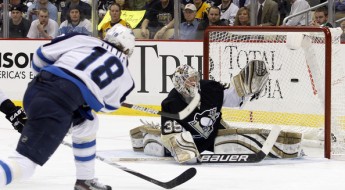3 Jets Under 23: Is Mark Scheifele a Top Line Center? (Part 2/2)
This is part two of a two part series. Check out part one here.
Mark Scheifele, Center, 22 years (7th overall in 2011)
 Since joining the league as a 20 year old in 2013, Mark Scheifele has always struck me as a player possessing that quality all scouts crave: intangibles. Although his post-game interviews are as boring and cliche as anyone’s in the league, he has displayed a strong desire to not only improve as a hockey player, but to be relied upon in critical situations. Scheif doesn’t want to score 50 goals, he wants to win 50 Stanley Cups.
Since joining the league as a 20 year old in 2013, Mark Scheifele has always struck me as a player possessing that quality all scouts crave: intangibles. Although his post-game interviews are as boring and cliche as anyone’s in the league, he has displayed a strong desire to not only improve as a hockey player, but to be relied upon in critical situations. Scheif doesn’t want to score 50 goals, he wants to win 50 Stanley Cups.
Other than having an absolute 100% buy-in to Paul Maurice’s philosophies, the former Barrie Colts star has size at 6’3″, great speed, and most importantly, a deadly and heavy release.
Scheif has steadily improved every year he’s been in the NHL, but with 12 goals and 10 assists in 35 games, there’s still plenty of room for convincing that he’s able to become a top-tier centerman. Last season he finished with 15 goals and 49 points, so he figures to score more goals this year, but his point totals are indeed trending down.
I don’t necessarily see this as a bad thing. With Mathieu Perreault and Drew Stafford/Nik Ehlers as his wingmen all year, it makes plenty of sense that he would generate more goals and less assists. Perreault and Ehlers are both strong playmakers and while Stafford certainly has the ability to score goals, Scheif had consistently been the focal point of the attack. Compare that to last year where he had an established scorer such as Blake Wheeler on his wing, and it isn’t terribly surprising that he’s getting less assists, but was on pace to almost double his career high of 15 goals before succumbing to injury. As long as he stays the primary shooter on his line, his goal total is a stronger indicator of his progress than his point totals – for now.
Best-case scenario: First line two-way goal scoring centerman
Worst-case scenario: Second line two-way centerman
Likely scenario: Top line centerman
Verdict: Scheifele is always striving to improve as a hockey player, and if you look at his stats from his time in the Ontario Hockey League, there isn’t a single season in the last 6 years where he hasn’t improved on his previous one. I don’t see that pattern halting any time soon, it’s just a matter of how high he can climb before he becomes a finished National Hockey League product. It is certainly reasonable to project he will be able to live up to his early first round expectations.
Josh Morrissey, Defenceman, 20 years (13th overall in 2013)
I’ll start out by saying that when he was 18, Morrissey put up 28 goals and 73 points in 59 games for Prince Albert of the WHL. That’s almost a 40 goal pace over an 82 game schedule, and the team wasn’t even very good – they finished 8th in their 12 team conference that season. Suffice to say the kid from Calgary, Alberta understands what to do in the offensive zone.
Of course, with Josh it has never been the offensive zone garnering the concern of the scouts. Slightly undersized at 6’0″, the question has always been whether he would be able to solve the defensive zone at the NHL level. With 6’4″ Ryan Johansen, 6’2″ Jamie Benn, and 6’4″ David Backes all playing within the division (never mind the towering centers in the Pacific Division), a clear obstacle has been laid out for Morrissey to navigate.
Morrissey relies on his exceptional skating ability to make up ground lost in size, and will be looking to emulate current undersized Jet Toby Enstrom’s defending capability. Sound positioning, an active stick and a constant study of angles will be required for him to adapt to the size and speed of the NHL. Morrissey is excellent at jumping up in the rush, and in his own zone evades forecheckers effectively and is able to transition the puck efficiently up ice. Everything to do with offense, the young man possesses. How long until his defence catches up?
Best-case scenario: Top pairing offensive defenceman
Worst-case scenario: Bottom pairing defenceman, power play contributor
Likely scenario: Top pairing offensive defenceman
Verdict: On the surface, it looks like Morrissey is going through some hiccups in the AHL. This is not at all uncommon for defencemen, particularly smaller ones. Through 37 games, he boasts an uninspiring 9 points. The Manitoba Moose this year have absolutely no offensive prowess (2.05 goals/game) so it is likely a reflection of the team more than the individual. He is averaging just under 2 shots per game as well, a solid rate for a first year pro. The Jets will most certainly exercise their patience with Morrissey, so he is not off course at all for his draft year billing of becoming a game changing offensive defenceman.
Andrew Copp, Center, 21 years (104th overall in 2013)

Copp will be looking to improve on his defensive positioning in order to carve out a role on the penalty kill.
Andrew Copp jumped to the big leagues straight after two successful seasons with the University of Michigan. In doing so, he accomplished what no other prospect was able to do the previous 10 years: steal the fourth line center job from Jim Slater.
Copp’s most noticeable attributes aren’t necessarily to do with skill, but more focused on intelligence and an understanding of a certain style he needs to play to be successful. Despite contributing 29 goals and 60 points through 69 games in his collegiate career, those numbers don’t figure to project at all at the NHL level. Instead, Copp will maintain his NHL job through reliable defensive play and competing hard along the boards and around the goalmouth.
Through the first 43 games of his NHL career, Copp is averaging a very modest 7:01 minutes per game. Part of that is a function of the Jets having a very strong third line – which cuts into 4th line time – and their league leading 3.67 times shorthanded per game doesn’t help in getting forwards 10 through 12 on the ice. As Copp continues to develop, he’ll want to improve on his 48.1% face off success rate, and eventually earn the trust of Maurice to play him on the penalty kill.
Best-case scenario: Checking third line center, penalty kill contributor
Worst-case scenario: AHL forward
Likely scenario: Fourth line center
Verdict: At the very worst, Copp’s NHL career only lasts a couple of years, or another Jets prospect surpasses him in the role he is eventually trying to earn (J.C. Lipon, perhaps?). Copp has shown enough consistency at the NHL this season to suggest he has the hockey sense required to grow into more than a fourth line player, and Maurice has rarely taken him out of the lineup. Every bottom 6 forward can add immense value to a team by becoming a reliable penalty killer, so that will be a large factor in determining just how big of a role the Ann Arbor native is able to carve out for himself.





Leave a Comment